
In the same way that I love pens and pencils, I also love watercolors and watercolor sets. So I was really excited when JetPens started stocking the Kuretake Gansai Tambi Watercolor Palette sets. The sets are available in a 12-color box ($17), and 18-color box ($23.50) and a 24-color box ($29). I got the 18-color set which is a lovely set. The set comes in a green, fabric covered box (almost like a chocolate sampler box in size and shape) with gold foil lettering on the cover. Inside, are extra large pans of watercolor paints.
Like all watercolors, you really need to swatch the colors to see what the colors will look like. In my swatches, you can see that the colors offer an array of three reds, an orange, a yellow, a yellow ochre, three shades of green, a turquoise, four shades of blue, a violet, black, white and a burnt sienna. This is a great assortment of colors that can be mixed to create even more colors. The most unusual color in the palette is the cornflower blue which is not usually a color I see in basic watercolor sets. I need to play with the colors a bit more to see how they mix and blend but the colors are all bright and vivid.

The individual pans of color are loose in the box so they can be removed and rearranged as you’re using them. The Gansai Tambi have some of the largest pans I’ve ever seen in a watercolor set. Most starter sets feature what is called a “half-pan” which is about the size of a cellophane wrapped caramel (my husband says “like a mini marshmallow”). The Gansai Tambi pans are about 1″ x 2.5″ – which is substantially larger, so you get a lot more room to swirl your brush and can dip a much larger brush into the pan without accidentally picking up other colors. The downside is that the Gansai Tambi box is that its not particularly portable. Its definitely a desk-sized set of watercolors. It also does not have any built-in mixing areas so you may want to add a mixing dish (something like this might work) to your supplies if you are using your Gansai Tambi set regularly.

The Gansai Tambi paints are described as “traditional Japanese watercolors” and, in use, they do seem a little different from other watercolors I’ve used. If you’re new to watercolor, what I can say is that the colors are slightly more opaque than other watercolor paints – not as much as gouache (which is a type of watercolor paint used mostly be designers and illustrators that can be very opaque and very matte in finish). The Gansai Tambi watercolors will dry with a slight shine to the paint if applied heavily.

In an effort to get a better feel about the difference between the Ganasi Tambi watercolors and other watercolors, I decided to find similar colors in my stash and do a side-by-side comparison. I used an array of Winsor & Newton, Sennelier and Daniel Smith watercolors, both tube and pan colors to make a close match. The swatches on the left are the :regular” watercolors and the swatches on the right are the Gansi Tambi set. Does this help show how the Gansai Tambi are a bit more opaque? I noticed it most with the black (#20 on the Gansai Tambi palette) which on the left is a lighter grey rather than a deep, solid black. I’m not saying one is better or worse, just different. And in being different, it makes the Gansai Tambi set a good investment for me. Its not just “more of the same” with this set of watercolors.

I marked my other watercolor samples as SEN for Sennelier, DS for Daniel Smith and W&N for Winsor & Newton. Overall, there is a lighter hue with the other watercolors than the Gansai Tambi. I couldn’t really match the #34, my closest option was W&N Opera Rose which is practically fluorescent.

The colors were quite similar with the exception of the #61 sky blue, I substituted it with one of Daniel Smith’s PrimaTek paint with a mica chip in it to be as funky as the pale sky blue.

The last comparison I did was with the opaque white. Most watercolorists don’t use a white but a lot of designers and illustrators will add opaque white as a final detail or touch up. I compared the W&N Titanium White with Gansai Tambi white. I laid down a layer of black gesso to see how opaque these whites are. The Gansai Tambi is a nice white but the W&N Titanium White is much more opaque, especially when dry.
Now, this comparison is probably largely unfair because a lot of my professional grade watercolors cost over $10 per pan or tube. So, two pans or tubes cost the same as the whole tray of great big pans. But I thought it would be a good chance to see if the colors in the Gansai Tambis were as clean and vivid as more expensive brands. I think it did a really good job for someone just getting started with watercolors. It may not behave exactly like traditional watercolors but I think you’ll have a lot of fun using them.
All the painted test were done on a Canson Edition 100% Cotton 9×12 Drawing Pad (250gms).
DISCLAIMER: This item was sent to me free of charge by JetPens for the purpose of review. Please see the About page for more details.

oooooOOOO those look so vibrant! Thanks for sharing!
Another timely post! I was just considering these today at the store. After seeing these colors, and for my watercolor needs, I may have to go back and get them soon.
I love these watercolors! They are pleasure to work with and you can’t beat the price!